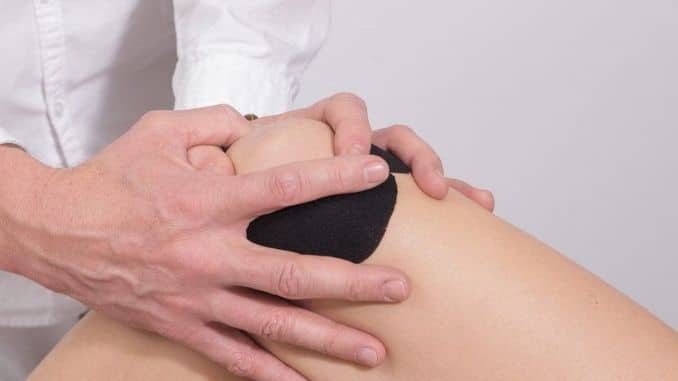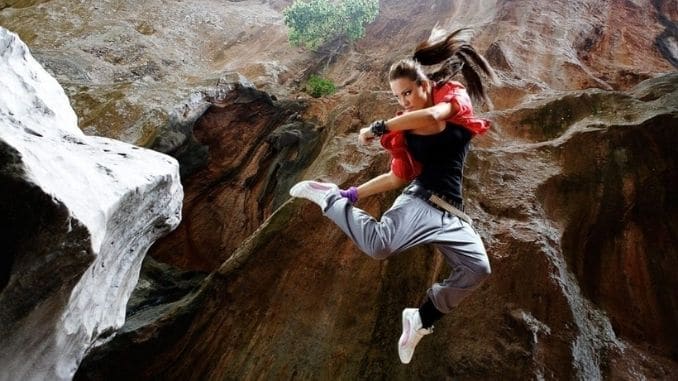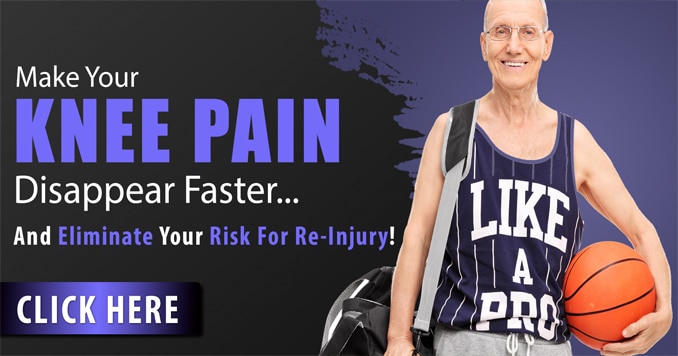
Arlene is an avid tennis player. She’s typically on the court three to four times a week. She loves the game and often plays competitively. Lately, though, she’s started to experience pain around her right kneecap. During the last game, it affected her enough that she had to stop early.
Arlene’s regular tennis partner, Carla, suggested that it could be “jumper’s knee.”
“I had it three years ago,” Carla said.
Arlene had never heard of it, but as Carla talked more about what she’d gone through, Arlene nodded her head. It sounded like a similar type of condition. Was that what she had?
If you think you may have a jumper’s knee, read on. We’ve got some exercises and stretches that can help.
What Is Jumper’s Knee?
Also called “patellar tendonitis” or “patellar tendinopathy,” jumper’s knee is an injury that occurs in the patellar ligament, which is often called a tendon.
In general, tendons connect muscles to bones and ligaments connect bones to bones. The patellar “tendon” connects the patella (knee cap) to the tibia (shinbone), so it’s actually a ligament. About 2 to 3 inches long, it’s made up of dense, regular connective tissues and strands of collagen and is situated right in the front of the knee, just under the kneecap.
The patella (knee cap) is also attached to the quadriceps muscles in your thigh by the quadriceps tendon. The patellar ligament is often considered an extension of that tendon, which is one reason why it may often be referred to as a tendon. It works together with the quadriceps muscles and tendon to bend and straighten the knee.
More specifically, the quadriceps muscles pull on the quadriceps tendon that, in turn, pulls on the patella. Then, the patella pulls on the patellar tendon and the shinbone, allowing your leg to straighten. When you want to bend the knee, the hamstring muscle — in the back of your leg — pulls on the tibia, which causes the knee to flex. The patellar tendon (ligament) is mainly responsible for transmitting forces from the thigh to the lower leg.
In jumper’s knee, the patellar tendon (or ligament) becomes damaged somehow. Small tears or “microtears” may form and the tendon may become inflamed. Some level of collagen degeneration also occurs, which weakens the tendon. Symptoms typically include pain below the knee cap and when bending the knee, stiffness in the knee and possibly pain in the quadriceps muscle. There may also be swelling in the knee joint.
At first, individuals are likely to feel pain only when doing the athletic activity but, without treatment, the condition will get worse and pain may start to become present even during rest. Doctors usually classify the injury based on severity as follows:
- Grade 1: Pain occurs only after training or exercising.
- Grade 2: Pain occurs before and after training but eases up after you’ve warmed up.
- Grade 3: Pain during training that limits your performance.
- Grade 4: Significant pain during exercise (or inability to exercise) and pain during regular daily activities.
In addition, the injury is usually labeled as:
- Acute: The injury just happened, and you’re experiencing pain for the first time; you haven’t had it for more than a week or two
- Chronic: You’ve experienced the pain several times in the past and have now suffered from it for more than a month
Do I Have Jumper’s Knee?
Jumper’s knee has one cause, and that is overuse. The injury is usually sports-related and is linked to repeated stress on the patellar tendon caused by frequent jumping on hard surfaces. Common activities that may result in jumper’s knee include:
- Jogging or running (particularly on hard surfaces)
- Weightlifting
- Jumping
- Sprinting
- Stop-and-go sports like basketball or volleyball
- High jumping or long jumping
- Soccer
Certain factors can increase your risk of a jumper’s knee injury. These include:
- Weak muscles around the knee
- Tight quadriceps muscles and/or hamstring muscles
- Muscle imbalance — some muscles in the legs are stronger than others, causing a pulling action on the patellar tendon
- Overtraining
- Shoes without the proper cushioning
- Overweight or obese
- A sudden change to the amount or intensity of your workouts
- Genetic predisposition — knees that are misaligned (as in bow-legged or knock-kneed), an abnormally high or low kneecap or fallen arches
- Direct injury to the patellar tendon
- Illness like kidney failure, autoimmune diseases like lupus and rheumatoid arthritis and metabolic diseases like diabetes affect blood flow to the knee that can weaken the tendon
Jumper’s Knee Solution: If you regularly participate in activities like those listed above or if you have some of the above risk factors and start to feel pain below your kneecap, it could be jumper’s knee. It also helps to zero in on the type of pain you’re having and when you experience it. Look for these signs:
- Pain in the front of the knee, below the kneecap
- Pain when pressing on the area
- Pain when bending or straightening the leg
- Sharp pain when jumping or running
- Pain that gets worse with time if you continue to play the sport
- Pain when kneeling or going up and down stairs
- Tightness in the knee
- Squeaking sensations when moving the knee
If you have pain in the back or on the side of the knee, it’s not jumper’s knee.
What Happens If You Don’t Treat Jumper’s Knee Properly?
Jumper’s Knee Solution: The problem with jumper’s knee is that because it’s an overuse injury, it often develops over time. That means that initially, the pain probably won’t be that bad, which may encourage individuals to ignore it. However, that’s a mistake.
Continuing to “work through” the pain will only cause more tears in the tendon. These tears are likely to get larger in time, causing more pain and reduced function. Without proper treatment, the condition can progress to a chronic one that is much harder to eliminate.
The problem is that each time the damage occurs, the body rushes in to try to repair it. If you don’t give it the time it needs, the repair is only partially completed before another tear occurs. The body responds by increasing collagen production, and the tendon can become thick and stiff. This makes it more difficult to repair and increases the odds that it will continue to cause problems.
How Do You Treat Jumper’s Knee?
Jumper’s Knee Solution: After a jumper’s knee happens for the first time, you may be able to heal it with simple at-home steps, including the following:
- Rest: Stop doing your athletic activities for about a week to give the tendon time to heal
- Ice: If there is inflammation, apply ice for 20 to 30 minutes at a time, four to six times a day; you may want to talk to your doctor or physical therapist about this as, in many cases, there is no inflammation initially with this sort of injury, so ice may not be necessary or even helpful
Once the pain subsides, doctors usually recommend specific exercises and stretches that will help facilitate healing. Knee supports, braces, athletic tape and straps may also be employed during recovery. However, methods of treatment vary depending on the severity of the injury and how long you’ve had it. Some examples:
- For those with a grade 1 injury, for example (as explained above), rest and ice over a period of 10-14 days should help
- For those with a grade 2 injury, physical therapy, along with avoiding running and jumping activities, will be prescribed; therapy focuses on range of motion, flexibility and strengthening
- For those with a grade 3 injury, rest for longer periods may be necessary while incorporating physical therapy techniques
- For those with a grade 4 injury, the tendon is likely ruptured and will require surgical repair
Recovering from jumper’s knee can take a few weeks to several months, depending on how severe the injury was. During that time, athletes can engage in other types of activities that don’t put pressure on the patellar tendon, like swimming. Realize that just because the pain diminishes doesn’t mean the injury is healed. Follow your doctor’s instructions.
If the injury doesn’t respond to the above treatment methods, doctors may also try other forms of treatment, including ultrasound, laser treatment, massage and injections.
Exercises That Help Jumper’s Knee
Jumper’s Knee Solution: The following exercises and stretches can help you recover from jumper’s knee and will also help prevent the injury in the first place. These are just a few examples, however. If you suffer from this injury, be sure to talk to your doctor about a thorough physical therapy program that will help you heal.
- Quad stretch: Stand or lie down, keep the knees together and pull the leg up behind you, grasping your toe. Pull it gently until you feel the stretch in your thigh and hold for 20 seconds. Repeat.
- Calf stretches: Place the balls of your feet on a step and let your heels drop down until you feel the stretch in your calf. You can also use a street curb.
- Hamstring stretch: Lie on your back and wrap a resistance band around the bottom of your foot, holding the ends in your hands. Raise that leg while pulling the foot toward you, keeping the knee straight. Hold for 20 seconds and release. Repeat.
- Hip flexor stretch: Get down on the floor, placing one knee on the floor directly underneath you and the other foot out in front with the knee bent at a 90-degree angle. Keeping the back upright, push the hips forward until you feel a stretch at the front of the hip and upper thigh. Hold for 10 to 30 seconds and repeat.
- Single leg extension: Lie down on your back and lift one leg straight up, then slowly lower back down. Repeat.
- Hip abductions: Lie on your side with your body in a straight line. Lift the upper leg, keeping the knee straight and the hip still. You should feel it on the outside of your hip.
Eventually, your physical therapist may suggest “eccentric” squats, which are performed on a board with a 25-degree decline and focus on lengthening the muscle through exercise. Some studies have shown that these types of exercises are more effective than other types for treating these injuries.
Jumper’s Knee Solution: How to Prevent Jumper’s Knee
To prevent a jumper’s knee from happening to you, follow these suggestions:
- Warm up before and after exercising — always stretch the quadriceps, hamstrings and calf muscles
- If you feel pain, stop and rest; don’t “play through the pain,” as you’ll only make the injury worse
- Strengthen the muscles around the knee, including the thigh muscles
- Work on your form — ask for help on how you’re performing to fix any movements that may be increasing the load on your knee.
If you want to take control of your rehab and relieve knee pain faster, then check out the Jumper’s Knee Solution program, here!
.





